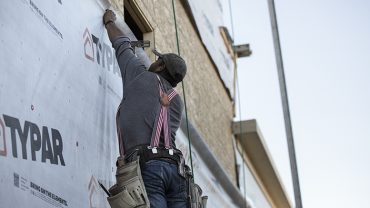
canadiancontractor
Benefit of taking a system approach to specifying and installing building wrap
The TYPAR Weather Protection System includes building wraps, flashings, construction tape and fasteners
This is a sponsored post from TYPAR
A weather-resistant barrier (WRB) alone—no matter how advanced it is—cannot be counted on to protect a structure from unwanted air and moisture movement without taking the whole assembly into consideration. They are part of a holistic approach to airtight construction, or at least they should be. As such, they require thorough, comprehensive integration with other elements of the building envelope in order to retain system integrity.
 For example, sealants with high solvent or plasticizer content can damage bitumen flashing products causing functional and aesthetic issues. When seams and tears are not properly taped, they allow windblown rain to infiltrate the assembly. Failure to use galvanized roofing nails or plastic cap nails to attach the WRB to the sheathing and framing can also compromise performance.
For example, sealants with high solvent or plasticizer content can damage bitumen flashing products causing functional and aesthetic issues. When seams and tears are not properly taped, they allow windblown rain to infiltrate the assembly. Failure to use galvanized roofing nails or plastic cap nails to attach the WRB to the sheathing and framing can also compromise performance.
To counter this problem, some manufacturers have developed a system approach including compatible tapes for seaming and adhesive flashings for openings. When installed together, these systems are often assured through extended warranties from the manufacturer. For instance, The TYPAR® Weather Protection System, which consist of TYPAR® Building Wraps, flashings, construction tape and fasteners, are engineered to work together and comes standard with a lifetime limited warranty, providing an unmatched level of security for both the builder and homeowners.
Equally important to product selection, however, is proper installation of the building wrap system and its components.
Considerations for Building Wrap Installation
Sealing all laps and penetrations with the proper tape can improve the building wrap’s performance by 20 percent. Horizontal laps are just as important as vertical laps because windblown rain can travel sideways or even up and over an improperly installed lap. Any tears and holes should be sealed with manufacturer-recommended tapes, and all windows and doors should be properly flashed. The goal should be to create a continuous building envelope free from any penetrations through which air could potentially pass.
During installation, it is also important the proper nailing pattern be followed to ensure the material is kept against the wall and not blown off. Galvanized roofing nails or plastic cap nails should be used to attach the air-barrier material to the structural sheathing and framing. Uncapped nails, staples, or screws can contribute to tearing and moisture intrusion—they must not be overlooked.
The simplest way to ensure the entire system works together effectively and meets all code requirements is to specify wrap, tapes, and flashing from a single manufacturer. Doing so provides added assurance each component comes together seamlessly; further, the system will be covered by the manufacturer’s warranty.

Leave a Reply